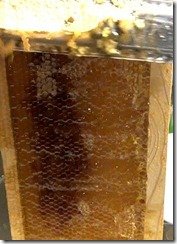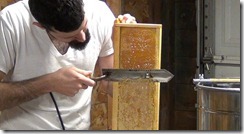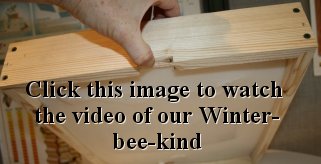How To Extract Honey
How To Extract Honey
Information on this site is provided by certified master beekeeper, David Burns. Information you can trust.
Watch Our Newest Beekeeping Videos
EXTRACTING HONEY FROM THE HIVE
We tell our students not to expect too much honey their first year because the colony is using a large portion of their incoming nectar to produce wax. Bees consume about 8 pounds of nectar to produce 1 pound of wax. In their second year, after their comb is built, more incoming nectar can be stored in honey supers. But, if all conditions are right, a first year hive can produce a large surplus of honey. Let me take you step by step through the whole process of taking the honey out of the hive all the way through putting it in a jar.
Find out more about harvesting honey in our online beekeeping courses.
 Honey bees ripen nectar by removing much of the moisture and when the moisture level is to their satisfaction (around 18%), they seal it off with wax, like putting a lid on a jar. This prevents the honey from drawing any additional moisture. You must be patient and wait for bees to cap the honey comb before you remove it. If you remove a frame of honey prior to it being sealed the moisture level in the honey will be too high and could cause the honey to ferment which will cause the honey to taste bad. Do not remove the frames of honey until they are fully capped over with wax. If you do have to pull out the frames prior to all of the cells being completely sealed, you can leave the frames in a room with a dehumidifier for a day or two and it will draw out moisture.
Honey bees ripen nectar by removing much of the moisture and when the moisture level is to their satisfaction (around 18%), they seal it off with wax, like putting a lid on a jar. This prevents the honey from drawing any additional moisture. You must be patient and wait for bees to cap the honey comb before you remove it. If you remove a frame of honey prior to it being sealed the moisture level in the honey will be too high and could cause the honey to ferment which will cause the honey to taste bad. Do not remove the frames of honey until they are fully capped over with wax. If you do have to pull out the frames prior to all of the cells being completely sealed, you can leave the frames in a room with a dehumidifier for a day or two and it will draw out moisture.
Next, make sure you have enough beekeeping hive equipment. Harvesting honey means your bees are large in number, may swarm this fall or in the spring. It also means that you probably could have placed more supers on than you did.
REMOVE THE BEES OUT OF THE SUPER
There are several ways this can be accomplished and no single way is better. It is simply a matter of what fits your style. So here are the most common ways:
a) Brush the bees off of each frame . I did this when I first started with bees. I would walk out to the hive with 10 empty frames in a medium super along with two top covers. I would lay the first top cover on the bed of my truck upside down. Then, I would place my empty super into the top cover. Then, I would take out the 10 empty frames and set them aside. I would remove one frame of honey at a time, from the hive and brush the bees off, then place it in the empty super in the truck. I would place my second top cover on the super box to prevent robbing. I would repeat these steps until I had brushed all the bees off all 10 frames. I would then place the new frames where I had removed the frames filled with honey to allow the bees to start drawing out the foundation.
b) Blow the bees out of the super. As our operation expanded I would load my air compressor into my truck with a generator to run it. I would open up a hive, and set the honey super on top of the hive on its front side. Then I would use my air compressor to blow off all the bees. The bees would land out in front of the hive and go back into the hive. This is the method that still works best for me. You can use a leaf blower if you do not have an air compressor.
c) Use bee escapes which allow the bees to exit but not re-enter. Featured below are the three most common bee escapes, the triangle, conical and Porter escape.
The triangle bee escape board goes under the honey super. Bees exit, but find it impossible to go back in through the maze.
Conical bee escapes work the same way, as this board goes under the super and the bees exit the small, red conical tubes but cannot re-enter. The side pictured faces down.
This Porter escape was invented by Mr. Porter in 1891 and fits into the inner cover oval hole. Bees exit but cannot re-enter.
Be aware that once these devices remove all the bees from your supers, the small hive beetle now has free reign throughout your honey supers. If you live in areas where SHB is well established, which is about everywhere now, you may be wise to use escape boards sparingly and instead use fume boards described next.
FUME BOARDS
Another common method to get the bees out of your super is to use a fume board. A fume board is placed on top of the super with a little chemical poured onto the fabric. This chemical has many names, but it is either Butyric Acid or Benzaldehyde which is a chemical that the bees do not like nor does any human who hates the smell of vomit. The bees run out of the super to get away from the bad smell and the super is empty within 5 minutes. If a beekeeper spills some on their clothing, they can empty out the nearest coffee shop in 5 minutes too! Many beekeepers love this easy method. I'm skeptical of the product being absorbed into the wax or honey and having an overall effect on the hive. However, smarter people than me have reassured me that these chemicals quickly evaporate.
HARVESTING FOR DIFFERENT TYPES OF HONEY
Honey from specific flowers does have a different taste. I would not begin to describe the differences but believe me it is different. Here's how to harvest specific honey. Essentially you must remove your honey supers after that particular flower stops giving nectar, and place new supers on before the bees change to a different source. This way, the honey will not be mixed from different sources. Of course, some mixing may happen, but you'll get more of the type that had the largest nectar flow. Sometimes this means pulling out only a few frames if all 10 are not ready.

Here is a picture of a frame that has a combination of light honey, and dark honey in the same frame. Sometimes a honey super may have contained a small amount of brood, but it appears more in the center in a circle starting at the bottom center of the frame.
Although this frame contains honey from two different sources, the dark honey is too small to extract separately so the two are combined. If you were going to enter your light honey in a contest, you should avoid a frame like this because the darker honey will darken the overall appearance ever so slightly.
Sometimes the comb is stained darker from darker honey. Sometimes it is a result of an area of brood that was laid in the honey super.
HOW MUCH SHOULD YOU FILTER YOUR HONEY?
 Here is a picture of Jesse using a hot knife to cut off the cappings. Hot electric uncapping knives as well as cold uncapping knives both do a nice job. Notice what the sealed area looks like. The capped area is white because the newly made wax is a bright color at first. As it ages it becomes darker. Once the comb is uncapped, the honey can be extracted. If you do not have an extractor, a frame can be left upside down to drip out overnight. This method requires a warm/hot room, at least 80 degrees. Let one side drain, then reverse the frame so that the other side of the frame can drain as well. You can squeeze or crush out the honey from the comb, but this destroys precious drawn comb that you could reuse.
Here is a picture of Jesse using a hot knife to cut off the cappings. Hot electric uncapping knives as well as cold uncapping knives both do a nice job. Notice what the sealed area looks like. The capped area is white because the newly made wax is a bright color at first. As it ages it becomes darker. Once the comb is uncapped, the honey can be extracted. If you do not have an extractor, a frame can be left upside down to drip out overnight. This method requires a warm/hot room, at least 80 degrees. Let one side drain, then reverse the frame so that the other side of the frame can drain as well. You can squeeze or crush out the honey from the comb, but this destroys precious drawn comb that you could reuse.
Once uncapped, place your frames in an extractor and spin the honey out. Once the honey is extracted out of the comb it collects in the bottom of the extractor which has a valve on the bottom. Most beekeepers strain their honey. Straining is different than filtering. We use a 400 micron strainer. These might be referred to as filters, but they are really strainers. We sell a lot of these nylon strainers that fit down over a 5 gallon bucket.
These strainers can be washed and reused over and over again. The honey flows very fast through these strainers and important elements of the honey are allowed to stay within the honey but foreign particles are strained out. Filtering honey usually involves warming the honey and pushing it through very fine commercial filters.
Some larger processors heat their honey and filter every grain of pollen from the honey so that the country of origin cannot be traced. In other words, there are some floral sources unique to particular countries, and pollen is often tested from imported honey so that illegally imported honey can be stopped. As a result, a large amount of honey purchased in larger stores has no traces of pollen.
We are okay heating honey to 90-95 because often the internal temperature of the hive is maintained at these temperatures. However, flavor and some nutrients are lost at temperatures above 120 (f). Honey does not need to be heated to be pasteurized. It is a pure and natural product and the only raw food that never spoils. It does not need refrigerated and can be kept at room temperature forever without spoiling. We allow our honey to sit after it has been strained. It sits for at least one week. Then we bottle it. Our settling tank allows all air bubbles to float up to the top. Then we drain from the pure honey at the bottom of the tank. You can do the same in a 5 gallon bucket with a valve on the bottom which we sell too. Most honey will become hard, known as crystallized. This is normal and does not mean the honey is bad. It means it simply crystallized. This can be remedied simply by leaving a jar in warm water or using a mildly heated double boiler.
A CLEAN HONEY ROOM
Keep a clean honey room. One drop of honey on the floor soon gets tracked all over the place. It is a messy job, but fortunately honey cleans up easily with water. After you are finished harvesting your honey, clean up all your equipment. Since honey is a natural product and all you are doing is bottling it, there are very few guidelines in most states. Check with your state and county for honey preparation. Here in Illinois, we passed legislation so that beekeepers can bottle up to 500 gallons of honey without inspections and permits. Since you will be giving away your honey or selling it, here are some common practices you should follow. Wear a hairnet, clean clothes, and keep your hands clean and properly wash all equipment including bottles. Use good judgment.
BOTTLING HONEY
Bottles are expensive. We use a combination of glass and plastic bottles. Many of our customers enjoy the small well liked teddy bear bottles. Bottles must be cleaned well, dried and free of any foreign objects and dust. A common bottle for us to sell is the quart jar. Most of our customers buy the one quart size and the traditional canning jar with canning lid is very cost effective.
When labeling your honey be sure to follow necessary guidelines. In most cases a label must state the following: Contact information, pure honey and weight. I usually like to state it is from America but that is implied if your address is your contact information.
You can include anything else on the label as long as it is truthful.

